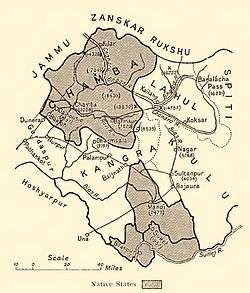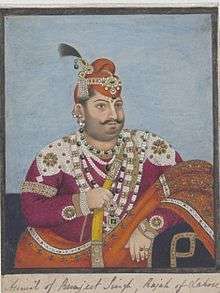Mandi State
| Mandi State मण्डी रियासत | |||||
| Princely State of British India | |||||
| |||||
|
Flag | |||||
 | |||||
| History | |||||
| • | Established | 1290 | |||
| • | Independence of India | 1948 | |||
| Area | |||||
| • | 1941 | 2,950 km2 (1,139 sq mi) | |||
| Population | |||||
| • | 1941 | 232,598 | |||
| Density | 78.8 /km2 (204.2 /sq mi) | ||||
| Today part of | Himachal Pradesh, India | ||||
| | |||||

Mandi State was a princely state within the Union of India from 1950 to 1956 with Bilaspur as its capital. The state of Mandi (the name means "market" in Hindi), which included two towns and 3,625 villages, was part of the States of the Punjab Hills. It was located in the Himalayan range, bordering to the west, north, and east on the British Punjabi district of Kangra; to the south, on Suket; and to the southwest, on Bilaspur. As of 1941, population of Mandi State was 232,598 and area of the state was 1,139 square kilometres (440 sq mi).[1]
History
Around 1290 the Rana of Banglaor succeeded to Siokot state. The new capital of the state, Mandi, was founded and the state took the name of its capital. The last ruler of Mandi signed the accession to the Indian Union on 15 April 1948.[2] Later by passing of The Himachal Pradesh and Mandi (New State) Act, 1954, the Mandi State was dissolved on 1 July 1954 and incorporated into the State of Himachal Pradesh as Mandi district, with an area of 2,950 square kilometres (1,140 sq mi).
Ruling family
- Raja Chhatar Sen, 2nd Raja of Mandi 1534/1554, married and had issue.
- Raja Sahib Sen, 3rd Raja of Mandi 1554/1575 or 1534/1554, married Rani Prakash Devi, daughter of the Raja of Bilaspur, and had issue.
- Raja Narain Sen, 4th Raja of Mandi 1575/1595 or 1554/1574
- Raja Keshab Sen, 5th Raja of Mandi 1595/1616 or 1574/1604, married and had issue.
- Raja Hari Sen, 6th Raja of Mandi 1616/1637 or 1604/1637, married and had issue. He died 1637 or 1623.
- Raja Suraj Sen, 7th Raja of Mandi 1637/1664 or 1623/1658, married (amongst others), a daughter of Raja Jagat Singh of Nurpur, and had issue. He died March 1664.
- Kumari (name unknown), married 1658
- Raja Shyam Sen, 8th Raja of Mandi 1664/1679 or 1658/1673, married and had issue. He died in 1673 (or 1679), when five Ranis, two concubines and 37 slave girls committed sati.
- Raja Gaur Sen, 9th Raja of Mandi 1679/1684 or 1673/1678, married (amongst others), a daughter of Raja Budhi Chand of Sirmur, and had issue, as well as illegitimate issue. He died 1684.
- Raja Sidhi Sen, 10th Raja of Mandi 1684/1727 or 1678/1719, married and had issue. He died 1727.
- Tikka Shiv Jawala Sen, married (amongst others), a daughter of the Rana of Hatli, and had issue. He died in 1703 or 1722.
- Raja Shamsher Sen (by a daughter of the Rana of Hatli)
- Raja Shamsher Sen, 11th Raja of Mandi 1727/1781, born 1722, married (amongst others), the daughter of Raja Ugar Singh of Chamba, and had issue. He died 1781.
- Raja Surma Sen, 12th Raja of Mandi 1781/1788, married and had issue, as well as illegitimate issue. He died 1788.
- Raja Ishwari Sen, 13th Raja of Mandi 1788/1826, born 1784, married 1stly, a daughter of Mian Fateh Chand Katoch, married 2ndly, a daughter of Raja Uggar Singh of Bashahr. He died in 1826.
- Raja Zalim Sen, 14th Raja of Mandi 1826/1839. He died in June 1839.
- Raja Balbir Sen, 15th Raja of Mandi 1839/1851, born about 1817, married several wives, and had issue, as well as illegitimate issue. He died 26 January 1851.
- Raja Bijai Sen, 16th Raja of Mandi 1851/1902, born 1846; married 1stly, 21 July 1859, a daughter of Raja Jagat Chand of Datarpur, married 2ndly, 25 July 1859, a daughter of Raja Jai Singh of Guler, married 3rdly, (name unknown), married 4thly, a sister of Mian Kishan Singh Guleria, married 5thly, a daughter of Mian Jagat Singh, married 6thly, a daughter of Mian Hira (or Udham) Chand of Datarpur, and had issue, as well as natural issue. He died 10 December 1902.
- Raja Bhawani Sen, 17th Raja of Mandi 1902/1912, born 17 April 1883, educated at Aitchison Chiefs College, Lahore; married 1stly, a daughter of Kanwar Balbir Singh of Sirmur, married 2ndly, a daughter of Mian Surat Singh of Suket, married 3trdly, 1907, Rani Lalit Kumari, died 4 May 1938, daughter of Raja Prithvi Dhwaj Shah, Talukdar of Khairigarh-Singhai, and had issue. He died on 9 February 1912.
- Interregnum 1912/1913
- Maj. HH Raja Sir Joginder Sen Bahadur, 18th Raja of Mandi 1913/1986, son of Mian Kishan Singh Sahib, born 20 August 1904, educated at Queen Mary's College and Aitchison College, Lahore; Indian Ambassador to Brazil 1952/56; Member of Lok Sabha 1957/62; Honorary Lt.-Col. 3rd/17th Dogra Regiment and Bengal Sappers and Miners, married 1stly, about 1911, a daughter of Thakur Devi Singh of Delath, married 2ndly, 8 February 1923, HH Rani Amrit Kaur, born 1904, died 1948, daughter of Col. HH Farzand i-Dilband Rasikhul-Itiqad Daulat-i-Inglishia *Raja-i-Rajgan Maharaja Sir Jagatjit Singh Bahadur of Kapurthala, and his wife, Rani Kanari, married 3rdly, 13 May 1930, Kumari Kusum Kumari [HH Rani Kusum Kumari of Mandi], born 27 August 1913, died June 1998, daughter of Kunwar Prithiraj Sinhji of Rajpipla, and had issue, two sons and two daughters. He died 16 June 1986.
Present Raja of Mandi
- HH Raja Ashokpal Sen, 19th and current Raja of Mandi(1986–present)
See also
References
External links
 Media related to Mandi State at Wikimedia Commons
Media related to Mandi State at Wikimedia Commons
Coordinates: 31°42′25″N 76°55′54″E / 31.70694°N 76.93167°E
